
Mastering the art of do-it-yourself (DIY) home maintenance is a skill worth its weight in gold. Homeowners who have home improvement know-how save money on labor and experience the rewards of completing a project all by themselves. In our comprehensive guide, we’ll share 25 DIY fundamentals, including everything from making a French cleat to sharpening a mower blade, so you’ll be ready to tackle a wide range of household tasks with confidence and skill.
1. Hang Heavy Stuff
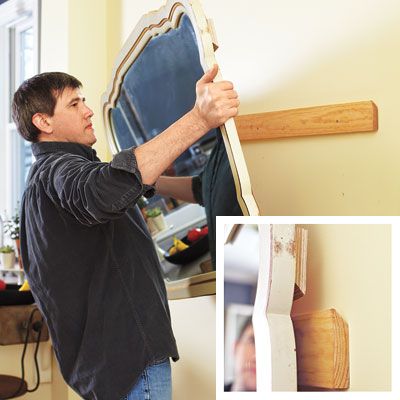
Studs never seem to be in the right place when you’re looking to hang an oversize mirror or wall-mounted cabinet. And those traditional hangers, such as nail-in picture hooks or large-thread drywall anchors, often rip out under loads greater than 25 pounds. The solution? A French cleat. If you have something wide enough to span between two studs, this hanging method can support a lot of weight, even if it’s off-center. Here’s how to make one:
- Use a table saw to cut a length of 3/4-inch plywood at a 45-degree angle, creating a beveled lip on one edge.
- Cut the strip into two equal pieces.
- Screw one strip to the wall studs with the lip facing up and away from the wall. Check that it’s level.
- Attach the other strip to your wall hanging, with the lip facing down and away.
- Lift the wall hanging into place so that its beveled strip interlocks with the opposing one on the wall.
- Paint the strips’ exposed ends to match your wall color.
Shown above: The beveled edges of two plywood strips fit together, forming a cleat to support hefty wall hangings.
2. Unclog a Sink
Instead of using a harsh chemical drain cleaner, which could eat away at your drain, roll up your sleeves and unclog that sink yourself.
Try This First
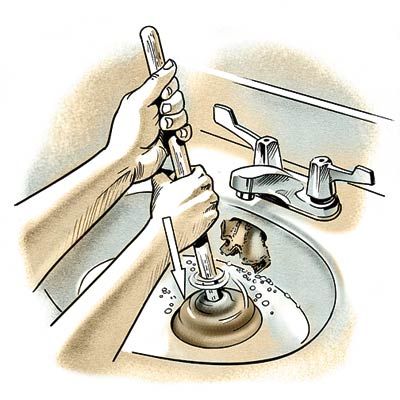
Attack the clog by:
- Filling the sink with water.
- Using a plunger, vigorously pump up and down over the drain.
According to Joseph Wood, owner of Boston Standard Plumbing & Heating in Massachusetts, you can direct pressure at the clog by stuffing a wet rag into the overflow hole.
Try This Next
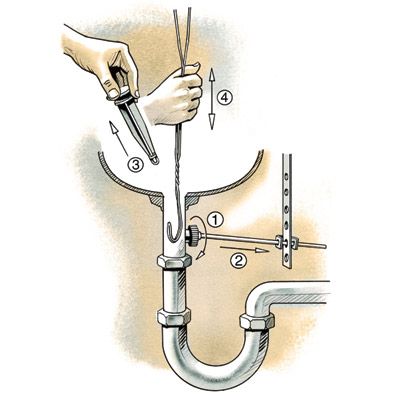
If that solution didn’t work, don’t worry. We have another trick up our sleeve, and we’ve included some visual guidance in the picture above. Try this next:
- Pop out the drain stopper (3) by unscrewing the nut (1) at the back of the drain pipe and retracting the pivot rod (2).
- Inspect the base of the stopper since that’s where hair and soap scum usually accumulate.
- Use a wire clothes hanger to extract any debris you find (4).
Still No Luck?
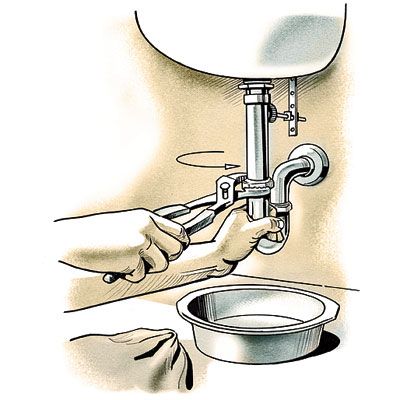
Our first two steps to unclog your drain may not have been effective, which means you have a persistent clog. It’s time to go deeper and address your clog down the drain line. We’ve included those steps below:
- Use tongue-and-groove pliers to remove the P-trap, twisting in the direction of the lower jaws. Have a bowl ready to catch any water.
- Inspect the trap for blockages.
- If the clog isn’t in the trap, remove the trap arm and feed a pipe snake into the stub-out to release the clog.
3. Cut In, Crisply
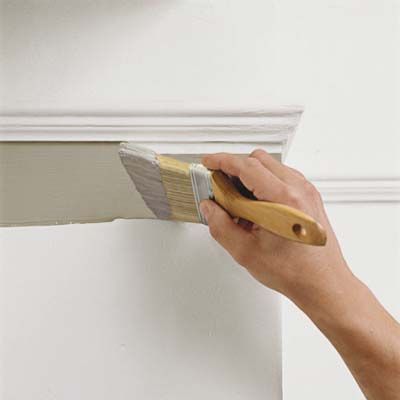
Painting a straight line at the intersection of walls and ceiling is what separates the pros from the hacks. To achieve a crisp, clean line where walls meet the ceiling:
- Choose a high-quality, 2 1/2-inch angled synthetic sash brush of medium stiffness.
- Dip the brush about halfway into the paint and tap it on the side of the bucket to remove the excess.
- Hold the brush parallel to the intersection and create a preliminary “glide strip” about 1/2 inch from the edge.
- Fill in the area between the strip and the intersection, working in long, steady strokes.
- Work from your elbow, not your shoulder, for better control.
- Feather your strokes to prevent paint buildup that could show through the roll coat.
Rich O’Neil of Masterwork Painting and Restoration in Bedford, Massachusetts, advises against squeegeeing the brush because you could end up with too little paint for a smooth application.
4. Free a Rusted Nut
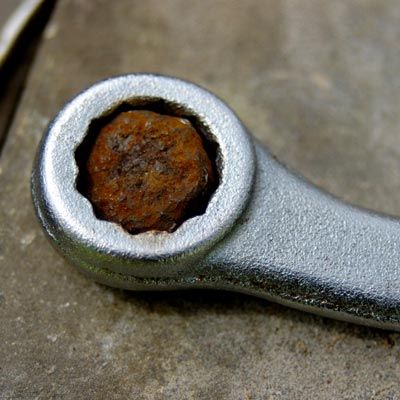
Stuck nuts can bring your project to a grinding halt, but you can get it and your project moving again. Here’s how This Old House‘s plumbing and heating expert Richard Trethewey gets those nuts unstuck:
- Try tightening first. If you can get it moving in either direction, you’re likely to succeed.
- Tap the nut with a hammer, using a nailset to focus the strike squarely on the nut.
- Apply heat with a hair dryer or heat gun to expand the metal, then attempt to loosen it.
- Clear visible rust with a wire brush, then apply penetrating oil, such as Liquid Wrench. Repeat over 24 hours if necessary.
Remember to use a socket wrench instead of pliers or adjustable wrenches that are prone to stripping nuts.
5. Drill Straight, Drill True
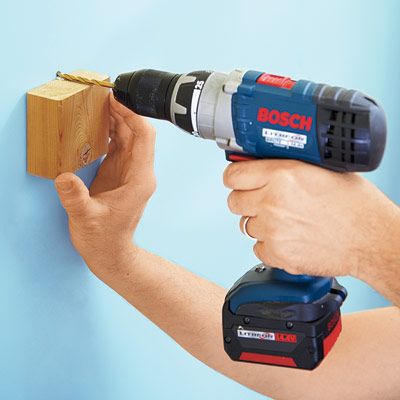
Drilling perfectly perpendicular holes can be a challenge, even for steady hands. This Old House’s master carpenter Norm Abram shares this foolproof technique below:
- Cut one end of a wood scrap square.
- Grab your combination square and draw a line perpendicular to the cut end.
- Hold the block against the wall and use the penciled line to direct your drill bit to your target.
- Begin drilling, using the block as a guide.
- Remove the block once the hole is started.
6. Sharpen a Mower Blade
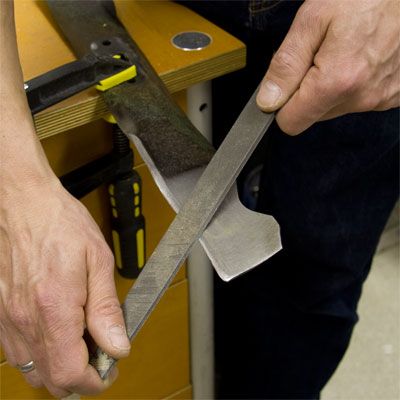
You could cart your lawn mower to the service shop, wait a day, go back, and fork over some cash to sharpen that dull mower blade, but you don’t have to. You could do it yourself in less than 30 minutes for free. Here’s how:
- Practice safety first by removing the spark plug to prevent accidental start-up.
- Tilt the mower following manufacturer instructions and secure the blade with a 2×4 scrap.
- Unbolt the blade and mark its face for correct reinstallation.
- Clamp the blade in a vise and use a 12-inch mill bastard file to sharpen the beveled edge.
- File in long passes, starting near the center and ending at the blade tip.
- Check balance by centering the blade on a nail driven into wood.
- Make extra passes to level the blade if needed.
7. Unstick a Door
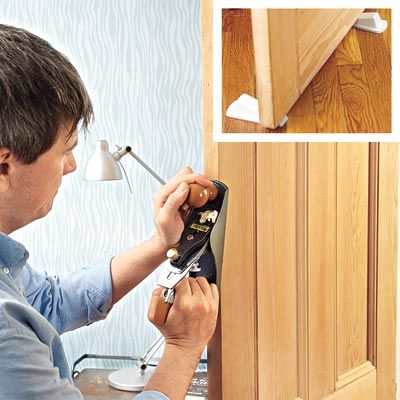
If your door swings just fine in the colder weather, but the humidity causes it to jam, you can unstick it yourself using This Old House’s general contractor Tom Silva’s recommendation, which we’ve included below:
- Take note of the sticking points and check for settled hinges or excessive paint.
- Aim for a 1/8 to 3/16 inch reveal between door and jamb.
- For localized sticking, use a bench plane to shave down high spots.
- Plane with long, smooth strokes at a slight angle.
- Sand planed edges with 150-grit sandpaper to smooth them.
If you believe lead paint is present, take proper safety precautions and use a liquid stripper before planing to avoid creating harmful dust.
8. Fix a Popped Floor Nail
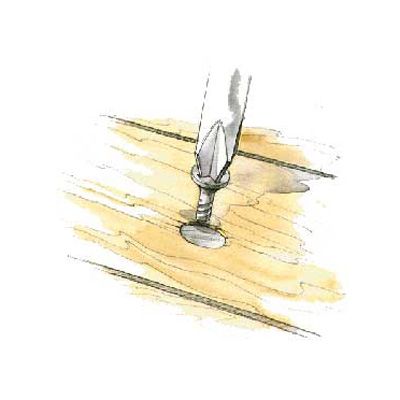
A protruding nail in hardwood flooring can rip up your socks and cut the skin on the bottom of your foot. Here’s a permanent fix:
- Use vise-grip locking pliers to pry out the offending nail.
- Place a wood block under the pliers to protect the floor surface.
- Replace the nail with a trim screw of similar length.
- Countersink the screw slightly below the floor surface.
- Cover the screw head with wood filler that matches your floor color.
9. Cut Crown Quickly
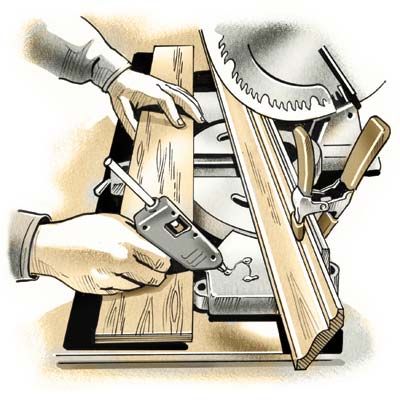
Installing crown is puzzling enough without having to align the molding’s bevels with a miter saw’s vertical fence on every cut.
Step 1
Here are some tips to simplify the process:
- Place the crown molding upside down on the miter saw with the ceiling edge on the deck and the wall edge against the vertical fence.
- Secure the molding with clamps.
- Cut a 30-inch plywood strip to serve as a horizontal fence.
- Apply hot glue dots to the saw deck on both sides of the rotating center.
- Press the plywood fence tight against the crown molding.
Step 2
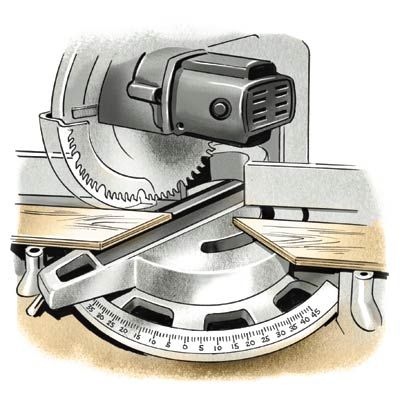
Continue the process:
- Remove the crown molding from the saw.
- Cut away the center section of the horizontal fence at 45 degrees in both directions.
This step creates clearance for the saw blade while maintaining the guide for the crown molding.
Step 3
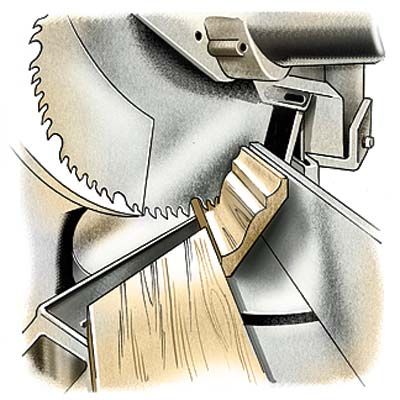
Complete the setup:
- Place the crown molding back on the saw, nestling it between the vertical fence and your new horizontal fence.
- The molding will be in the correct orientation for mitering.
- Make your cuts knowing the molding is properly positioned.
10. Find a Stud
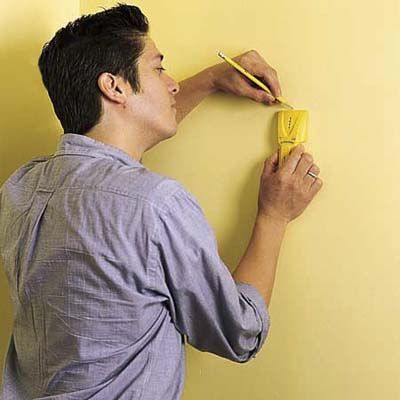
Pinpointing studs can be difficult, especially in thick plaster walls. The best way to locate one requires a combination of techniques:
- Use a battery-powered or magnetic stud finder to sweep the wall and locate approximate stud positions.
- Measure 16 or 24 inches to either side to find adjacent studs.
- Confirm stud centers with the stud finder.
- Verify by tapping the wall with a screwdriver handle. You’ll either hear a hollow sound that indicates space between studs or a solid thunk which likely means you’ve found a stud.
- With drywall, you can wave a flashlight across the surface to scope screw holes or drywall tape, telltale signs of a stud.
11. Extract a Stripped Screw

When faced with a stripped screw, try this method:
- Switch from a drill/driver to a manual screwdriver that matches the screw type.
- Use a hammer to gently tap the screwdriver tip into the screw head, setting it firmly.
- Apply strong downward pressure while slowly turning the screwdriver to back out the screw.
12. Safely Work Above Stairs

It costs a pretty penny to rent some scaffolding or specialized ladders to work on stairs. Instead, follow Silva’s instructions to create a DIY platform so that you can access high, sloping ceilings above stairs:
- Place a step ladder at the top of the stairs.
- Position an extension ladder on the stairs, leaning against the opposing wall (use padding to protect the wall).
- Create a platform by screwing two-by-fours to a plywood deck.
- Nail stops to the ends of the two-by-fours to prevent sliding.
- Place the platform across the two ladders.
13. Make Square Crosscuts
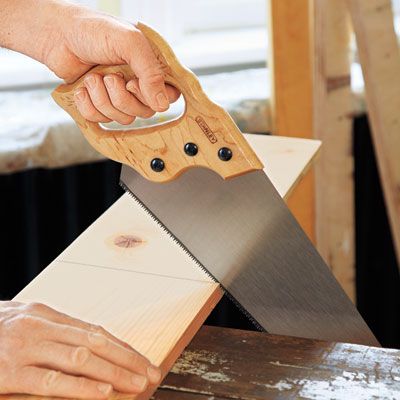
Abram shares this trick to get perpendicular saw cuts:
- Rest the saw teeth on the edge of the cutline.
- Look for the reflection of the wood edge in the saw blade.
- Adjust the saw slightly until the reflection aligns with the actual edge.
- Begin cutting, maintaining this alignment throughout the cut.
This will help prevent straying off the cutline or angling the blade as you saw through the wood.
14. Carry Plywood
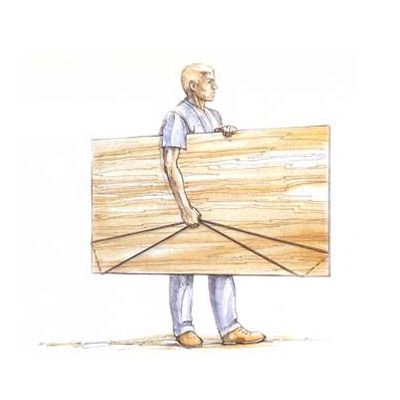
Save your back when transporting plywood with this simple carrier:
- Create a loop with a 20-foot rope by tying the ends together.
- Slip the loop around the two bottom corners of the plywood sheet.
- Reach over and grab the center sections of the rope on either side.
- Lift the board, tucking it under your arm.
15. Stain Without Blemishing

Uneven absorption can cause stained wood furniture or trim to look blotchy. For even staining on wood furniture or trim, follow these tips:
- For hardwoods, such as maple or oak, restain lighter areas while they’re still damp.
- Remove dark spots by rubbing them with a rag dipped in mineral spirits.
- Stain within 15 minutes of applying the conditioner for best results.
- When working with softwoods, such as pine, apply a clear conditioner first to partially block wood pores.
16. Paint with “Sprayed-On” Results
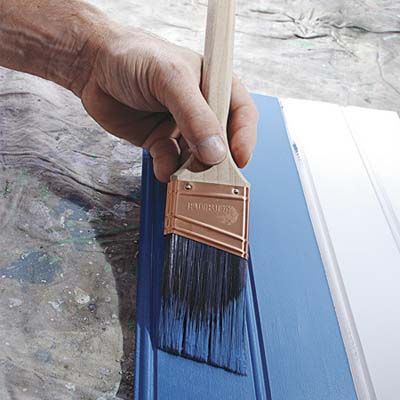
You can achieve a smooth, factory-like finish on trim with these steps:
- Sand the surface to remove imperfections, then vacuum and wipe with a tack cloth.
- Apply a high-build primer and sand with 220-grit paper when dry.
- Filter 100% acrylic latex gloss paint through a strainer bag.
- Mix in a latex paint conditioner to improve flow and slow drying time.
- Use a top-quality synthetic brush, applying paint in long strokes.
- Finish with a light stroke using just the brush tips to smooth the surface.
- Allow to dry, then lightly sand between coats with 220-grit paper.
17. Replace a Broken Tile
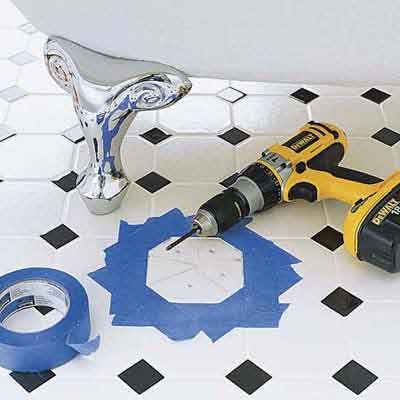
To swap out a cracked tile without damaging the other ones:
- Rake out the surrounding grout with a carbide-tipped scraper.
- Protect adjacent tiles with painter’s tape.
- Drill evenly spaced holes in the broken tile with a 1/4-inch masonry bit.
- Tap out tile pieces from the center outward.
- Clear away old thinset and apply new thinset to both the replacement tile and substrate.
- Press the new tile into place and allow it to dry overnight before grouting.
18. Cure a Loose Hinge
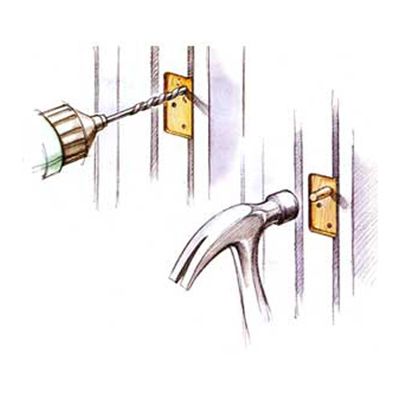
Below we’ve included the different steps to fix loose hinges on cabinets and doors:
For cabinet hinges:
- Remove the screw and plug the hole with a glue-dipped toothpick.
- Let the glue dry, snap off the excess, and reinsert the screw.
For door hinges:
- Support the door with a wood block.
- Remove the loose hinge leaf and drill out the stripped hole with a 3/8-inch bit.
- Glue a 3/8-inch wood dowel into the hole.
- When dry, drill a pilot hole and drive in a new, longer screw.
19. Drill the Perfect Pilot Hole
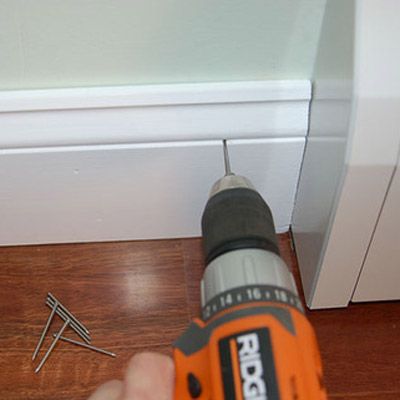
Driving a nail into the end of a piece of wood could cause it to split. Try this technique to create precise pilot holes:
- Place a finishing nail into your drill after snipping off its head.
- Use this makeshift bit to create a guide hole for your screw or nail.
20. Shoot Smooth Caulk
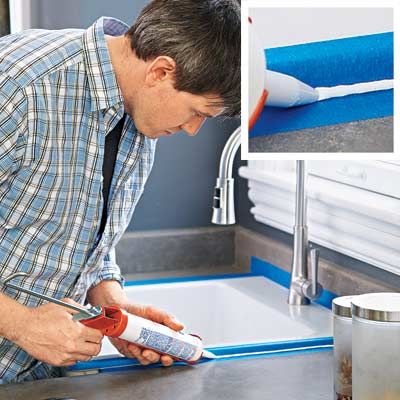
You can get clean and precise caulk lines every time by following these steps:
- Apply parallel strips of painter’s tape about 3/16 inch apart along the seam.
- Cut the caulk tube nozzle at a 45-degree angle to match the gap width.
- Apply caulk between the tape strips.
- Smooth silicone sealant with a soap-dipped finger—use water for acrylic latex caulk.
- Remove tape while the caulk is still wet.
- Make a final pass with a damp finger to eliminate small ridges.
21. Cinch Down a Load
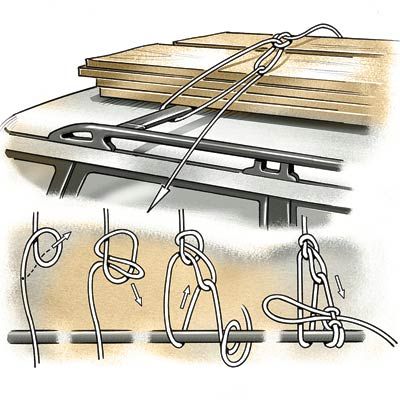
To cart lumber atop your vehicle, the trucker’s hitch is the knot to know. This method creates a loop that tightens and cinches down your load. Here’s how:
- Create an overhand knot in the middle of your rope.
- Thread the tail end through the loop and over the load.
- Pull the tail end tight and wrap it back through the loop.
- Cinch down the loop by tightening the pull, creating a secure hold.
22. Drive a Nail
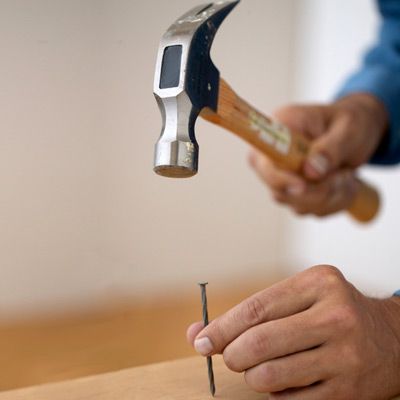
Hit the nail on the head by using our hammering technique:
- Choke up on the handle of a 16-ounce hammer and give it several light taps.
- Grip the handle near the butt and deliver steady blows by swinging from the elbow, not the shoulder, letting the weight of the hammer do the work.
- Keep your forearm and wrist stiff throughout the swing until the very end, when you snap the wrist for extra oomph.
- Instead of hammering the nail flush, and risking mauling the surrounding wood, leave the head protruding and countersink it with a nailset.
23. Salvage Molding
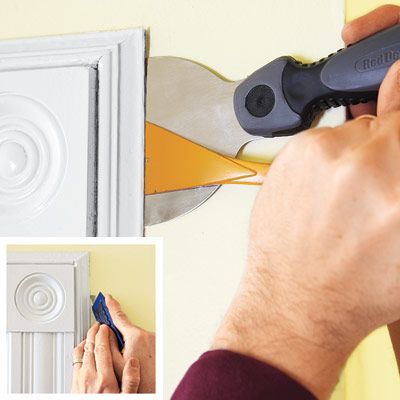
An old home’s interior trim might well be one-of-a-kind, especially elaborate window and door casings. If you’re renovating and want to spare the molding, follow our tips below:
- Work a 3-inch wall scraper behind the trim, sliding it the length of the piece while exerting outward pressure.
- Slip a pry bar into the widened crack with the scraper behind it to protect the wall as you rock the pry bar.
- When the trim is free, pull nails through its unfinished backside by leveraging with end nippers or tongue-and-groove pliers.
Keep in mind that hammering nails back through the face can cause the wood to splinter and damage the painted surface.
Shown above: Slice the painted seam where wall and trim meet, to ease removal of the molding and prevent finish damage.
24. Limb a Tree

You know that tree limb needs to go, but you don’t want to damage the tree or yourself. So, what should you do? Follow the three-cut method:
- Using a pole saw, first cut halfway through the underside of the limb at a distance of 1 to 2 feet from the trunk.
- Make the second cut 3 inches farther out on the top side. The limb will snap and drop.
- Now saw off the stub at an angle just beyond the branch collar. Never cut flush with the face of the tree—it can impede healing.
Remember that safety always comes first. Take proper precautions and wear the right gear. And call a professional if you aren’t an experienced DIYer.
25. Prune a Rosebush
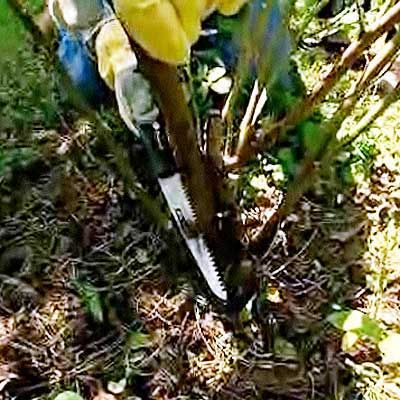
For most modern rose varieties that bloom abundantly on new growth, prune aggressively. Just be sure to wear long gloves so that you don’t get stuck by thorns. Here’s how to prune your roses in the late winter to early spring:
- Cut out all dead and diseased canes at the base using a pruning saw. You can also cut old canes, which look woody rather than green.
- Cut back the strongest to about 6 inches above soil level with hand pruners.
- Lop off less vigorous shoots at 2 to 4 inches. Cuts should be angled and 1/4-inch above a bud.
